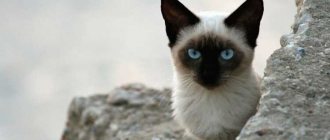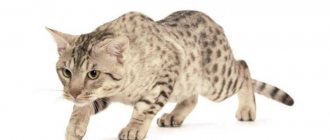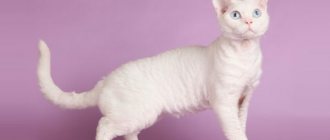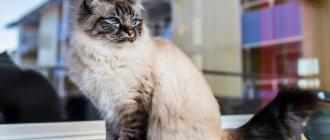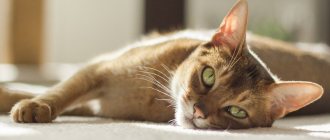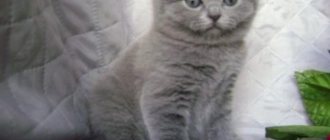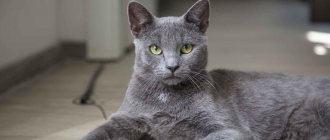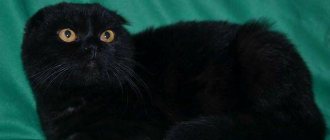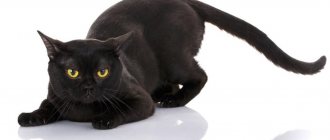Review author: “ZooVita”
Abi are very beautiful animals. In the photo, Abyssinian cats appear very elegant and graceful. Their floppy-eared and big-eyed kittens look incredibly cute.
But still, before getting a cat of this breed, it is worth learning about the characteristics and possible problems of such animals. This will help you avoid difficult situations, possible disappointments and be one hundred percent ready for all surprises, both pleasant and not so pleasant.
Origin
Abyssinian cats are representatives of one of the most ancient breeds. Their origin is a mystery shrouded in darkness. There are many theories about this. Let's take a look at the history of the breed, based on the most reliable facts.
Previously it was believed that the breed originated in Ethiopia, which at that time was called Abyssinia. The name was given accordingly. This theory was confirmed by the presence of ancient Egyptian frescoes with images of cats extremely similar to Abyssinian ones.
Indeed, Abi have a great external resemblance to African cats, but recent studies indicate a lack of relationship. Rather, Abyssinian cats appeared in East Asia on the coast of the Indian Ocean.
One way or another, Abyssinians were bred and registered in Great Britain at the end of the 19th century. Later they were brought to America. The American and English branches of the breed developed separately, but after World War II there were almost no Abyssinian cats left in Europe.
The breed was restored thanks to American animals. It is American abies who have slender and sophisticated forms that seem more traditional now.
Abyssinians received large, wide-set ears in the process of crossing from oriental cats, when they actively participated in their breeding.
Ancestors and relatives
The ancestors of the Abyssinians were most likely wild inhabitants of North Africa and Ethiopia. At the very least, Libyan and North African wild cats closely resemble this breed.
Wild cat wines such as the marsh lynx and the jungle cat are very similar to the Abyssinians.
Description of the breed
Let's move on to the description of the Abyssinian cat. Abyssinians are medium-sized cats with a muscular, graceful body. Abyssinian cats are mostly shorthaired.
Please note ⭐⭐⭐
Oriental cat: characteristics of the breed, health, care and maintenance, rules for raising a kitten, price (150 photos)
Neva Masquerade cat: photo, description of breed and character, size, weight and color, pros and cons of the St. Petersburg cat
- American shorthair cat: description of the breed, its character and care, nutrition (100 photos)
The large ears are set far apart and the expressive, large green or gold eyes are almond shaped. Standard life expectancy is 12-15 years.
Abies are highly intelligent and easy to train. They are very hardy, but at the same time energetic and playful cats.
Representatives of this breed are quite friendly and sociable. Abyssinians are able to get along with people of any age, as well as with other pets.
Caring for an Abyssinian
Everything is simple here. No special conditions are required when keeping this breed. Amazing wool actually doesn't require much maintenance.
Note!
Singapore cat: character, photo, price, breed description, reviews, how to buy, how to choose, maintenance, care and owner reviews
Scottish Straight: cat photo, kitten prices, breed description, character, reviews, maintenance and care, nutrition + interesting facts
- Chausie - overview of the breed, character and breeding characteristics. Price for a kitten and tips for choosing a purebred cat (115 photos)
Cats practically do not shed. Combing out fluff, etc. not required. Just don’t forget to bathe the animal and trim its claws as required.
Another significant point is the southern Abyssinians. Their fur is not adapted to frost. Try not to keep the animal in a cold room.
You can feed such a cat with both ready-made food and regular food. Initially, representatives of this breed do not have any food preferences. They will willingly eat boiled meat, poultry, milk, cottage cheese and eggs.
Do not give your pet smoked, fried or salty foods, especially those flavored with spices or salt beyond measure. However, this advice applies to owners of any pet, not just Abyssinians.
Character and habits
The character of the Abyssinian cat is open and friendly. Like small children, they are interested in everything that comes their way, love to play and are very attached to people.
Genetics of color
The unusual color of Abyssinian cats is a kind of calling card of the breed. It is caused by the presence in the genotype of animals of several genes, the combination or dominance of which determines coat color:
- The dominant agouti gene is “Ta”. It detects the presence of ticked hairs.
- Gene "Ttb". When dominant, it displays a “tiger” coloration.
- Gene "U". Smoothes out differences in coat color. When it is dominant, the pattern does not appear.
The color of a purebred Abyssinian cat depends on the combination of these genes planned by the breeders. Their influence has a prolonged effect. A kitten may be born with a pattern on its fur - spots or stripes, which will disappear over time.
Important! Experienced breeders claim that the presence of stripes in kittens is a defect of the breed. If the kitten has a gray, faded undercoat, this is evidence of a crossbreed.
The white spotting gene causes the appearance of spots on the belly and muzzle, white “socks” and the tip of the tail. These signs are not considered a defect, but they try not to use such animals for breeding.
Affectionate and gentle
Abyssinian cats are affectionate and courteous. They do not tend to offend people or other animals.
Please note ⭐⭐⭐
Burmese cat - photo of the sacred cat, pet care and keeping at home (110 photos)
- British shorthair cat - features of cat care, its colors, selection of proper nutrition (110 photos)
Ragdoll - 120 photos, description of appearance and color, her character, how she gets along with other pets
Rays of the sun
A distinctive feature of this breed is its very unusual coat. Because of this, the Abyssinian cat is also called the sun cat or the rabbit cat. Its soft, short, but silky fur resembles that of a rabbit.
The color of the cat's coat is also very unusual. Each hair is evenly colored with dark and light stripes, reminiscent of the sun's rays.
This color is called ticking. The skin looks simply gorgeous - it shimmers in the sun and simply shines dazzlingly.
Health
Abies in general are not sickly animals, but some possible hereditary diseases are worth mentioning.
Genetic changes in the breed
Oddly enough, the ancestor of the blue Abyssinian cat is its black progenitor (see photo). The structure of the coat (ticking) has several tones in one hair at the same time. Eumelanin, the black color gene, is responsible for the color of the hair coat. Hair ticking into sandy, yellow and gray colors is a mutational transformation of the black gene. Simply put, a hundred shades of black.
The washed out black color creates a blue-gray tint. The saturation of granules in the hair cavity is distributed unevenly, changing the range from the skin to the end of the hair. And ticking completes the creation of a unique suit.
Types of genes responsible for the color of the cover:
- B - dominant black color;
- D - tone thinner;
- dd—recessive position of gene D;
- A—ticking gene;
- L - gene0 influencing the length of the coat, in this case, short.
Pyruvate kinase anemia
A hereditary disease that usually progresses slowly. It is completely impossible to cure it. You can only maintain your pet’s well-being with various medical procedures, nutrition and care.
The disease is inherited, and the cat itself may not be sick, but be a carrier of the disease. On average, every fourth kitten of such a cat will have pyruvate kinase anemia.
General information about color
The shimmering effect of Abyssinian fur is due to the peculiarities of its color. Upon careful examination, you can see that each hair is colored zonally: dark areas alternate with light ones.
The standard is to have at least 3 stripes. There is no clearly defined pattern on the cat’s fur, there are only smooth color transitions. This color is called ticked. The hairs are short, dense, and have a small undercoat. Usually it is 1-2 shades lighter than the main color.
As a result of many years of selection, the main characteristics common to all color types were fixed in the Abyssinian breed:
| Part of the body | Addition characteristics | Characteristic features of color |
| Frame | Proportional, muscular, medium size | Presence of a dark stripe along the ridge |
| Tail | Long, wide at the base, tapering at the tip | Presence of a dark stripe |
| Neck | Slender elongated | Presence of a closed necklace |
| Head | Wedge-shaped, clear profile, large ears | Without a pronounced pattern. Exception - blue color |
| Eyes | Large slanted almond-shaped | Color: green, copper, gold, all shades of brown. Clear, dark outline outline |
Interesting! Abyssinian cats are more expensive and are valued higher than male cats. This is explained by the fact that females are born 3-4 times less often than males.
Undesirable deviations
The characteristic coloring, corresponding to the standard, appears in Abyssinians with age, around the 3-4th month of life. At first, the fur of kittens is velvety and fluffy, its color is inexpressive and faded.
Over time, the coat changes, the young Abyssinian acquires a fur coat, color and quality that meets the standards. Clearly defined patterns on the coat of an adult animal are considered a fault, but white spots on the collar and chin are acceptable.
If the conformation standards are fully met, the following characteristics are considered a breed defect:
- the color of the paw pads is different from the color of the fur coat;
- the presence of stripes on the paws and tail;
- lack of dark eyelid rim;
- dark spots or pattern on the face;
- an open “necklace” on the neck;
- the color of the undercoat is very different from the base coat;
- hairs have less than 3 color segments;
- absence of a dark stripe along the spine.
A lighter color of the belly within the base color range is allowed. The undercoat of a purebred cat must be in the color range of the main tone, but lighter and brighter.
The presence of gray, dull tones in the Abyssinian undercoat is unacceptable.
Kidney amyloidosis
One of the main diseases of the breed is kidney amyloidosis. Abyssinians are prone to developing kidney failure. The life expectancy of a sick Abyssinian is on average 5-6 years. There is no cure for this disease.
Types of colors
The main types of coat color of the Abyssinian cat:
- classic wild;
- blue;
- sorrel;
- faun.
In addition to the four main colors included in the breed standard, there are other types of colors of Abyssinian cats:
- lilac;
- brown;
- tortoiseshell;
- black.
Black Abyssinian cats are spectacular and elegant. Despite the fact that this color is not included in the standard, they are popular.
In fact, the fur of these cats is dark chocolate or black-gray. The belly is lighter - gray or brown.
It is difficult for breeders to achieve the consolidation of black color in the color, because there are very few Abyssinians with black ticking.
Classic wild color
At first, this color was the only color standard for the Abyssinian cat breed. Today this is the most common and popular shade. It contains rich ocher, brown, and black tones.
Compliance with standards is determined by the following parameters:
- ticking must be uniform, at least 3 segments;
- the sides and back are painted a darker ocher-brown color than the lower part of the body;
- the paws have black fringes;
- a black stripe runs along the entire length of the ridge;
- the nose is terracotta-colored, clearly defined;
- eyes the color of gold, walnut, emerald.
Different degrees of shade intensity are allowed. It is important that no extraneous colors are mixed into the basic ones.
Interesting! All kittens are born with blue eyes. Only by the age of ten months do their eyes acquire a color that matches their color.
Sorrel
Sorrel translated from English means “bay, red.” This color is warmer than the classic one; it is dominated by red shades of wool, the color of copper, apricot, and chocolate.
Characteristics:
- the main ticking background can be of two types: dark chocolate or cinnamon color;
- The presence of black hairs in the wool is unacceptable;
- the tummy and paws are colored apricot on the inside;
- dark stripe on the spine and tail;
- the pale pink nose is outlined in red;
- paw pads pink-beige;
- eyes are the color of gold and copper, greenish or dark hazel shades are acceptable.
Interesting! The Sorrel color is unique to Abyssinian cats. It is very rare and almost never occurs in other breeds.
Blue
This type of color was approved relatively recently. The name of the suit was given by a delicate smoky blue tint. The combination of pearl, beige and slate gray shades in the ticking segments gives an unusual effect.
Standard requirements for an Abyssinian blue cat:
- on the frontal part of the muzzle there is a pattern similar to the tails of a tailcoat;
- on the lower part of the body from the chin to the tummy, the color of the coat is light beige and apricot tones;
- along the ridge there is a narrow stripe of a tone more saturated than the main color with a pronounced bluish tint;
- the nose is blue-gray or terracotta in color with a clear dark outline;
- paw pads pale pink;
- the undercoat should be lighter than the base color, but not whitish;
- eyes are golden, copper in color, less often green or hazel.
Interesting! According to cat lovers, Abyssinian blue eyes are particularly beautiful and expressive.
Faun
Translated from English, faun means fawn. This is the rarest shade of the Abyssinian cat. The color is similar to sorrel, but less intense.
The exquisitely colored Abyssinian fawn cat is incredibly elegant. Thanks to her plasticity, she looks like a lioness and is graceful like a deer.
Color characteristics:
- ticking with segments of coffee, cream, beige, chocolate with milk color;
- along the spine to the tip of the tail there is a stripe of a rich pink-beige hue;
- the undercoat is lighter and brighter than the main color;
- the pink nose is outlined with a reddish outline;
- the belly and paws are covered with gray-beige fur;
- Eye color must comply with breed standards.
The owners of Abyssinians are firmly convinced that the character and temperament of a cat depends on its color:
- wild ones are proud, independent and extremely intelligent;
- sorrel - cheerful and perky;
- fauns and blues are gentle and sensitive.
Nutrition and care
Caring for such cats is quite standard and is not much different from caring for representatives of other breeds. Their fur is not long and only needs brushing once a week. When shedding, you need to brush your pet more often.
For washing, you should use breed-appropriate, high-quality shampoos that can be purchased at a pet store. Ear cleaning and nail care are also necessary, just like for cats of any other breed.
Meat is suitable as food, since cats are carnivorous animals. As a side dish you can serve oatmeal, wheat or buckwheat porridge, as well as zucchini, beets and carrots. An adult cat needs to be fed twice a day.
Water should be constantly available to your pet. If you would like to feed your Abyssinian food, then you should consult with a specialist on this issue and, with his help, choose the most suitable one.
There are an incredible variety of smart, beautiful, friendly and incredibly cute pets in the world. And Abi, as it turned out, is no exception. Now, knowing all the features of this breed, you can easily decide whether you should get cats of this breed.
If according to the standard
Representatives of this breed are quite elegant and miniature. Even males do not weigh more than 7 kg. Males grow up to 32-33 cm in length (not counting the tail), and females - no more than 28 cm.
The limbs of Abyssinian cats are graceful and slender, quite long, like the tail. Large ears slightly protruding to the sides, elongated almond-shaped eyes.
Even in the photo, the Abyssinian cat looks very graceful. This impression is only enhanced if you see the animal in motion.
As for the unusual fur of the animal, the standards for Abyssinian cats allow four colors: sorel (bright red fur), fawn (beige), blue and wild - brown. The latter is considered the most popular.
Photos of Abyssinian cats
Diseases and treatment
Abyssinians are an ancient and healthy breed, as evidenced by the life expectancy of an Abyssinian cat up to 15, and often up to 20 years. They are prone to the following hereditary diseases:
- pyruvate kinase deficiency is a blood disease in which red blood cells are destroyed due to a lack of the enzyme pyruvate kinase;
- progressive retinal atrophy - the death of the light-sensitive receptors of the retina, which leads to blindness;
- renal amyloidosis - deposition of amyloid protein in the kidneys.
Of the acquired diseases, Abyssinians are characterized by:
- gingivitis - inflammation of the gums, often develops from poor nutrition;
- allergies - food, to pollen or materials from which surrounding objects are made, manifested by a skin rash and itching;
- hypersensitivity is a neurological disease in which cats lick themselves too much, to the point of partial hair loss;
- luxation of the patella is a displacement of the kneecap, which can be acquired with age, due to injury, or congenital.
Timely vaccination will protect your cat from the most common infectious diseases. The first vaccinations for animals are often given by the breeder at the age of about two months. They are revaccinated after two to three weeks, and then vaccinated annually. Like other cats, Abyssinians are vaccinated against:
- panleukopenia;
- herpes virus infection;
- caliciviruses;
- chlamydia;
- leukemia;
- immunodeficiency;
- viral peritonitis;
- dermatomycosis;
- rabies.
Even if your pet does not go outside, this does not guarantee its safety from infection. All cats must be vaccinated.
Photo review
Photos of Abyssinian cats fascinate with the grace, elegance and hidden strength of these animals.
Top nicknames
Very often, the names of these cats emphasize their connection with the Middle East and Africa. But besides the real history and myths about the breed, you can choose a nickname for the Abyssinian based on your literary and musical preferences or based on the character and appearance of the cat itself.
For example, you can call an Abyssinian cat “boy”:
- Iran;
- Sandro;
- Dallas;
- Cairo;
- Presley;
- Caliph;
- Moses;
- Justin;
- Ramses;
- Shaitan.
You can call an Abyssinian cat “girl”:
- Sahara;
- Cleo/Cleopatra;
- Nubia;
- Lynx/Puma;
- Naomi;
- Beatrice;
- Isabel;
- Olivia;
- Cercea;
- Juno.
